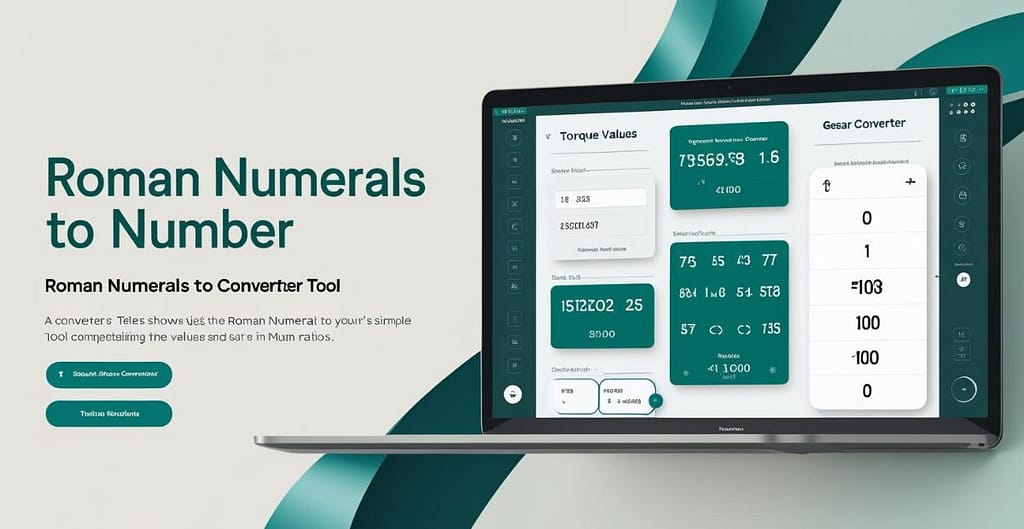Roman Numerals Converter
Convert between Roman numerals and standard numbers with our accurate conversion tool. Perfect for students, historians, and enthusiasts.
Roman Numeral to Number Converter
Try these examples:
Understanding Roman Numerals: A Comprehensive Guide
Roman numerals are a numeral system that originated in ancient Rome and remained the standard way of writing numbers throughout Europe for many centuries. Even today, they are still used in various contexts such as clock faces, book chapters, movie credits, and monument inscriptions. Understanding how to read and convert Roman numerals is valuable for historians, students, and anyone interested in classical history and numbering systems.
Roman Numeral Symbols and Values
I
1
V
5
X
10
L
50
C
100
D
500
M
1000
Rules for Writing Roman Numerals
Basic Principles:
- Numerals are written from left to right, with larger values preceding smaller ones
- When a smaller numeral appears before a larger one, it is subtracted
- Only I, X, and C can be used for subtraction
- I can only be placed before V and X
- X can only be placed before L and C
- C can only be placed before D and M
- A numeral cannot be repeated more than three times in succession
- V, L, and D are never repeated and never subtracted
Common Roman Numerals and Their Values
| Roman Numeral | Number | Roman Numeral | Number |
|---|---|---|---|
| I | 1 | XL | 40 |
| IV | 4 | L | 50 |
| V | 5 | XC | 90 |
| IX | 9 | C | 100 |
| X | 10 | CD | 400 |
| XIV | 14 | D | 500 |
| XIX | 19 | CM | 900 |
| XX | 20 | M | 1000 |
| XXXIX | 39 | MMXXIII | 2023 |
Practical Applications of Roman Numerals
Clock Faces
Traditional analog clocks often use Roman numerals to mark the hours, adding a classic aesthetic to timepieces.
Book Chapters
Many books use Roman numerals for preliminary pages, chapter numbering, and volume indicators.
Monuments and Buildings
Cornerstones of buildings and monuments often display construction dates in Roman numerals.
Movie Credits
Film production years and copyright dates frequently appear in Roman numerals in movie credits.
Numbering Outlines
Academic and legal documents often use Roman numerals for hierarchical numbering in outlines.
Monarch Names
Royal names often include Roman numerals to indicate succession order (e.g., Elizabeth II, Louis XIV).
How to Use Our Roman Numeral Converter
Our Roman numeral converter provides two-way conversion between Roman numerals and standard numbers:
- Roman to Number: Enter a Roman numeral in the first field and click “Convert Roman to Number”
- Number to Roman: Enter a number between 1 and 3999 in the second field and click “Convert Number to Roman”
The tool handles all the complex validation and conversion behind the scenes, ensuring accurate results every time. Whether you’re deciphering an ancient inscription or creating content with a classical feel, our converter provides precise conversions instantly.
Limitations of Roman Numerals
While elegant and historically significant, Roman numerals have several limitations compared to modern Arabic numerals:
- No concept of zero, which greatly limits mathematical operations
- Cumbersome for arithmetic calculations
- Limited range (traditional Roman numerals only go up to 3,999)
- No place-value system, making large numbers difficult to represent
- Subject to interpretation with multiple valid forms for some numbers
Frequently Asked Questions About Roman Numerals
The concept of zero as a number was developed much later than the Roman numeral system. Ancient Romans had no need for a placeholder digit or the concept of zero as a quantity. The Roman numeral system was designed for counting and recording quantities, not for complex mathematical calculations that require a zero placeholder.
In the standard classical form, the largest number is 3,999 (MMMCMXCIX). However, various extensions have been created to represent larger numbers, such as using a vinculum (overline) to multiply values by 1,000. For example, V̅ would represent 5,000. These extended systems are not standardized and are rarely used.
There are several theories about why clocks often use IIII instead of IV for the number 4. One popular theory is that it creates visual symmetry with the VIII on the opposite side. Another theory suggests that IV might have been avoided because it was an abbreviation for the Roman god Jupiter (IVPITER). The IIII tradition remains common in clockmaking to this day.
Our converter uses precise algorithms based on the standard rules of Roman numerals to ensure high accuracy. It validates inputs according to classical Roman numeral conventions and handles both conversion directions correctly. For most educational, historical, and practical purposes, our converter provides perfectly accurate results.
Yes, there are some variations in how Roman numerals were used historically and in different regions. The “subtractive” notation (like IV for 4 instead of IIII) became standard relatively late. Medieval documents sometimes show non-standard forms. However, modern usage typically follows the classical rules implemented in our converter, with subtractive notation for 4 (IV), 9 (IX), 40 (XL), 90 (XC), 400 (CD), and 900 (CM).

Use our more free tools at earnapki
Charge Converter
Torque Converter
Frequency Converter
QR Code generator tool